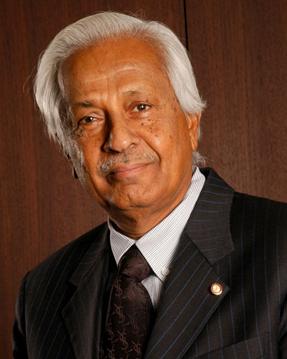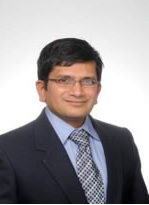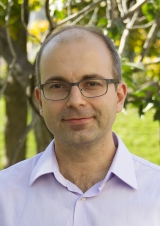Bio
I was a postdoctoral researcher in Biosignals and Systems Analysis Lab at Bio-engineering Department, McGill University, Montreal, Canada. From November 2017 to December 2018, I was a postdoctoral researcher in Biomedical Signal Processing Lab at the School of Electrical Engineering and Computer Science, University of Ottawa, Ottawa, Canada. From July 2016 to October 2017, I was a postdoctoral fellow at Electrical Engineering Department, Concordia University, Montreal, Canada. In April 2016, I graduated with a PhD degree from Signal Processing Laboratory, at Concordia University, Montreal, Canada.
Education
-
Postdoctoral Fellow2019
Bio-engineering Department
McGill University, Montreal, Canada
-
Postdoctoral Fellow2018
School of Electrical Engineering and Computer Science
University of Ottawa, Ottawa, Canada
-
Postdoctoral Fellow2017
Electrical and Computer Engineering Department
Concordia University, Montreal, Canada
-
PhD2016
PhD - Electrical Engineering
Concordia University, Montreal, Canada
-
MSc2010
Master of Science - Electrical Engineering
Shahid Beheshti University, Tehran, Iran
-
BSc2007
Bachelor of Science - Electrical Engineering
Khaje Nasir University, Tehran, Iran
Work Experience
-
July 2019 - NowData Science Team, Groupe Dynamite Inc.
-
2023 - 2024Montreal Section Chapter Chair for the IEEE Consumer Technology Society
-
2023Publicity & Patronage chair at the 2023 IEEE Sensors Applications Symposium, Ottawa, Canada.
-
2022Executive chair at the 2022 IEEE 5G World Forum, Montreal, Canada.
-
Jan 2021- Dec 2022Chair of the IEEE Montreal Section
-
2021Executive chair at the 2021 IEEE 5G World Forum, Montreal, Canada.
-
Jan 2019- Dec 2020Postdoctoral Fellow
As a postdoctoral fellow at McGill University, I was involved in a time-varying functional brain connectivity related project using artificial intelligence. More specifically, using multimodal neuroimaging data (simultaneous fMRI-EEG, MEG), I investigated the time-varying characteristics of resting-state networks over different time scales, as well as quantifying the effect of physiological fluctuations (pressure, heart rate, respiration) on fMRI-based resting-state connectivity.
-
Nov 2017- Dec 2018Postdoctoral Fellow
As a postdoctoral fellow at University of Ottawa, I was involved in several projects at Biomedical Signal Processing Lab including: (i) I worked on vital sign monitoring using contactless ultra-wideband radar. More specifically, respiration and heartbeat rates of human subjects were estimated and the posture of targets were detected in a room environment using supervised learning. (ii) In an activity monitoring project, I worked on event recognition problem for home care purposes. More specifically, several algorithms were developed using time-frequency analysiss, time series analysis and deep learning approaches to build an automatic system for detetcion and prediction of fall incidents in senior houses and to assist the elderly living alone.
-
Aug 2018- NowChair of the IEEE Montreal Industry Relations Committee
Organized The 7th IEEE Research Boost: to promote industry driven research.
Organized The 6th IEEE Research Boost: to foster collaborative research projects and networking among the industry, government and academia.
Organized The 5th IEEE Research Boost: to bring together IEEE Members, Academics, Industry, Public Sector and Students to network and enjoy an inspiring technical presentation and discussion.
-
2017Part-time Faculty, Concordia University
Course instructor in ENCS6021-Engineering Analysis II.
Delivered lectures to 44 graduate students at Concordia University. -
May 2017- July 2018Co-Chair of IEEE Montreal Industry Relations Committee Event Planners Team
Organized The 4th IEEE Research Boost to foster collaborative research projects and networking among the industry, government and academia, as well as to present some of the top candidates in their field of expertise.
Organized IEEE Montreal Keynote Event: Cars of the Future, to bring together IEEE Members, Academics, Industry, Public Sector and Students to network and enjoy an inspiring technical presentation and discussion.
Organized The 3rd IEEE Research Boost to foster collaborative research projects and networking among the industry, government and academia, as well as to present some of the top candidates in their field of expertise.
-
Jul 2016- Oct 2017Postdoctoral Fellow
As a postdoctoral fellow at Intelligent Signal & Information Processing Lab , I worked on analyzing large-scale data using graph-based signal processing. This work was partnered by Ericsson Montreal with a focus on intrusion detection in cloud systems by online auditing. I also worked on graph-based reachability assessment of the cloud entities in cloud networks. Graph signal processing framework has recently emerged to extend high-dimensional data analysis to networks and irregular domains, and thus, many existing signal/image/video processing, machine learning problems can be revisited from a new graph-based perspective. In view of this, I initiated my research on graph signal processing by investigating the capability of the graph-based filtering for edge-preserving smoothing of images, and accordingly its application in image abstraction and stylization. A unified iterative filtering was developed to perform detail manipulation and fine detail boosting in parallel. In addition, an alternative filtering approach was established in the graph Fourier domain, resulting in noticeable gain in image compression and restoration. Further, I expanded the applicability of the graph signal processing framework by developing an intrusion detection method for distributed sensor networks based on statistical properties of the graph signals. The probabilistic dependence graph was further used for fault detection and localization in smart grid.
-
Sep 2012- Apr 2016Teacher Assistant and Lab Instructor
As a Lab Instructor at Concordia University, I was responsible for conducting lab tutorials on DC/AC circuits, transformers and DC motor for a group of 20 students. Assisting students in using various hardware tools such as Oscilloscopes, Multimeter and Wattmeter. As a Teacher Assistant and Head TA, I was responsible for training, assisting and supervising a team of 21 teacher assistants, where I demonstrated strong leadership and organizational skills along with a solid work ethics. I coordinated TAs (21 sections), prepared material for tutorial sessions and solutions for assignments, organized midterm exam and prepared the midterm problems, and assigned and coordinated invigilators for the midterm test.
-
Sep 2011 - Apr 2016Research AssistantConcordia University
As a research assistant in multimedia signal processing research group at the department of electrical and computer engineering, I conducted research on the processing of image and video signals with special references to their space-time-frequency representations, statistical modeling, developing various estimation and detection techniques, experimentations, and performance studies. Specifically, 1) A unified probabilistic model for the contourlet coefficients of the image signals was developed using the alpha-stable family of distributions. An important motivation for using such distribution was the non-gaussian behavior of the contourlet coefficients of images as well as an appropriate number of parameters that could be used for a better modeling performance. 2) The performance of the probabilistic model was investigated in various types of contourlet representations such as real/complex, and shift-variant/invariant. In particular, the statistics of the data samples were analyzed in terms of the transformation matrices and mathematical operations of the transform. 3) The performance of the developed model was investigated in several estimation techniques such as denoising (reducing additive white Gaussian noise), despeckling (reducing multiplicative and correlated noise), deblurring (restoration from the degradation due to point spread function), and fusion (obtain an informative signal from multi-sensed data). Estimation performances were evaluated on several data sources that include natural images and video, medical images, and remote sensing images. 4) The performance of the developed model was also studied in the case of the detection of edge and textures and the detection of watermark for copyright protection.
-
Jun-Sep 2005InternshipIran Telecommunication Research Center I worked on Tunneling methods in Virtual Private Networks (VPNs).
Professional Service
-
20232023
Session Chair in IEEE Conference on Consumer Electronics (ICCE), Las Vegas, USA.
2017Session Chair in IEEE Canadian Conference on Electrical and Computer Engineering (CCECE), Windsor, Canada.
2016Volunteer in organizing IEEE Signal Processing Society Winter School on Distributed Signal Processing for Cyber Physical Systems, Montreal, Canada
Technical Reviewer
IEEE Transactions on Image Processing
IEEE Transactions on Multimedia
IEEE Transactions on Information Forensics & Security
IEEE Transactions on Signal & Information Processing over Networks
Transactions on Circuits & Systems for Video Technology
Transactions on Circuits & Systems II: Express Briefs
Elsevier Signal Processing
IET Image Processing
Elsevier Signal Processing: Image Communication
Springer Journal on Circuits, Systems & Signal Processing
Wiley International Journal of Imaging Systems and Technology
BioMedical Engineering
OptiK

Technical Program Committee (TPC) and reviewer
International Symposium on Circuits and Systems (ISCAS)

International Conference on Current Research in Signal Processing & Communications.
Mid-West Symposium on Circuits and Systems (MWSCAS)
Canadian Conference on Electrical and Computer Engineering (CCECE)
Iranian Conference on Electrical Engineering (ICEE)
International Conference on Information Science, Signal Processing and their Applications (ISSPA)
International Conference on Industrial Electronics & Applications (ISIEA)
2004Volunteer in organizing Electrical and Computer Engineering Conference, Tehran, Iran
Honors and Awards
-
Nov 2023Best Service Award, IEEE Montreal Section
-
August 2023Invited Talk at the Department of Engineering, Brock University, Saint Catherine, Canada.
Subject: Radar sensor and its applications in healthcare automation
-
Feb 2021Invited Talk at IEEE Ottawa Section Engineering in Medicine and Biology Society, Ottawa, Canada.
Subject: Pervasive Healthcare through Human-centered Sensing
-
Apr 2020Invited Talk at the Department of Information Technology, École de technologie supérieure, Montreal, Canada.
Subject: Contactless Monitoring for Pervasive Healthcare
-
Mar 2020Invited Talk at the School of Information Technology, Carleton University, Ottawa, Canada.
Subject: Contactless Monitoring for Pervasive Healthcare
-
Jun 2019Invited Speaker at Fields Centre for Quantitative Analysis and Modelling lab, Ottawa, Canada.
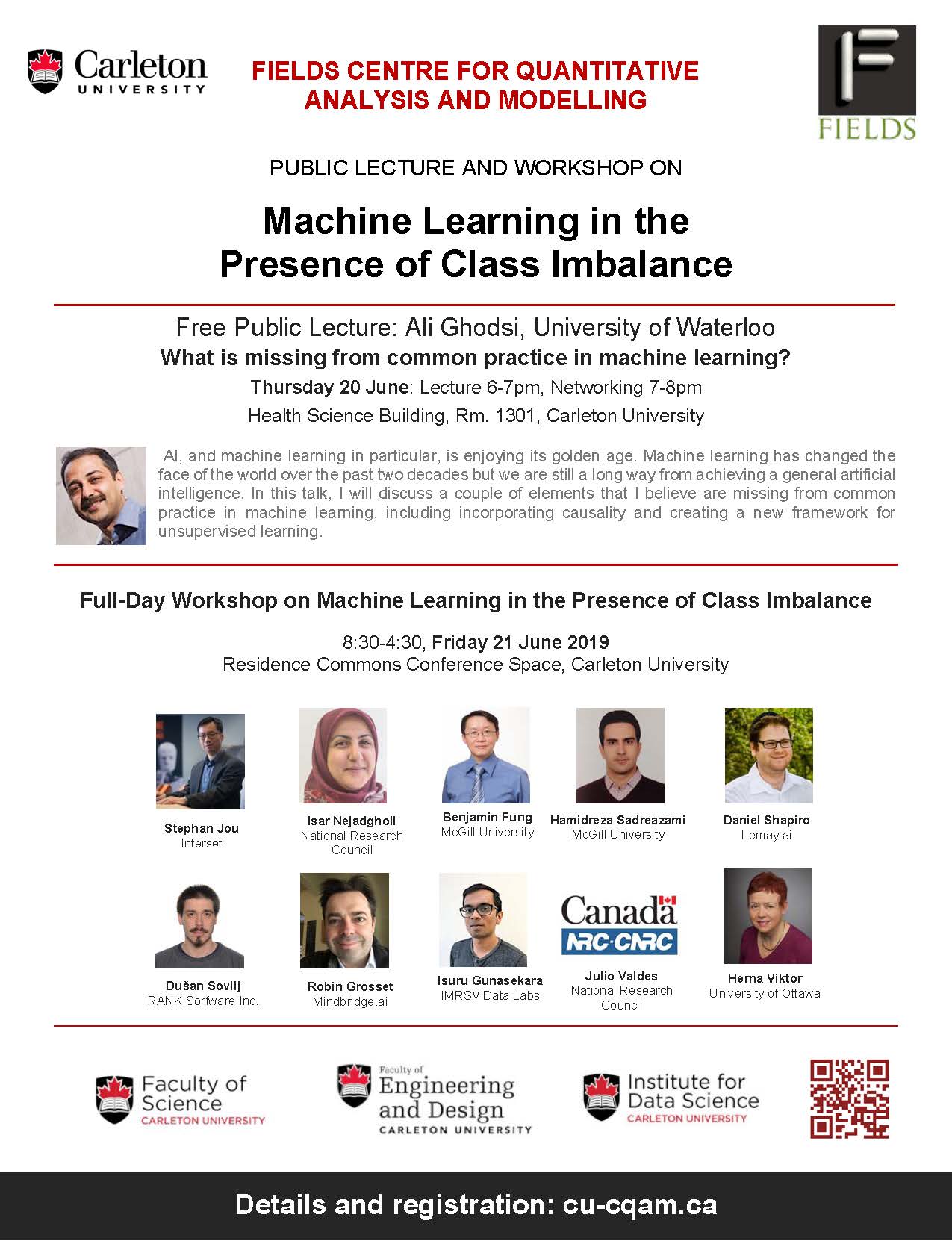
-
Jan 2019Invited Speaker at Khaje Nasir Toosi University (KNTU), Tehran, Iran.

-
Nov 2018Volunteer Recognition Award, IEEE Montreal Section
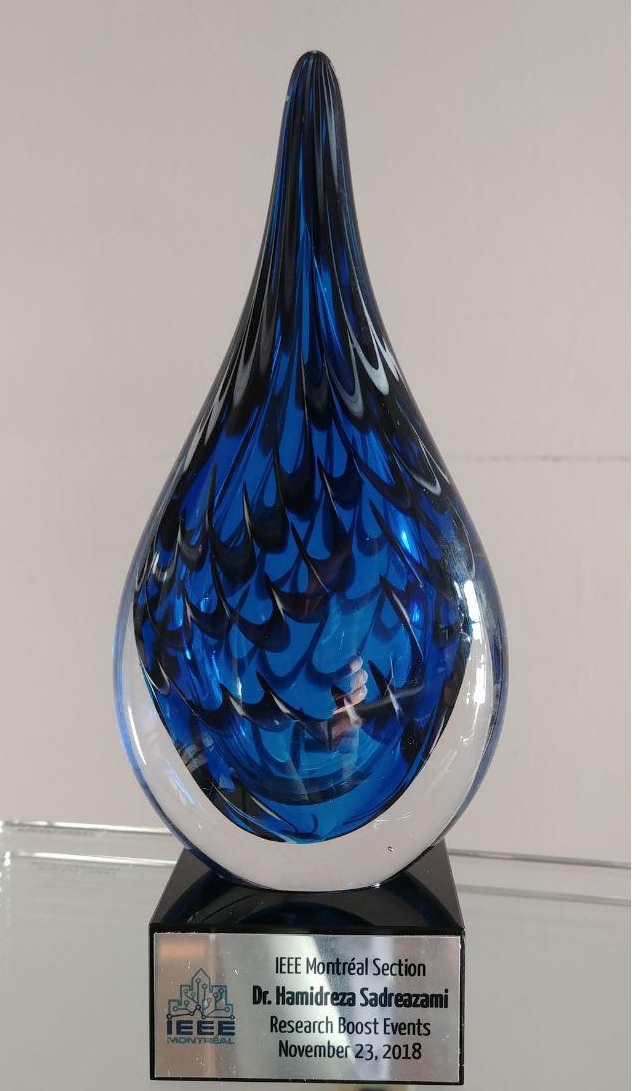
-
Apr 2018Ranked second in the Nature and Technology category to receive an FRQNT postdoctoral fellowship
-
Apr 20171st place award in IEEE Research Boost competition, ETS Uni.
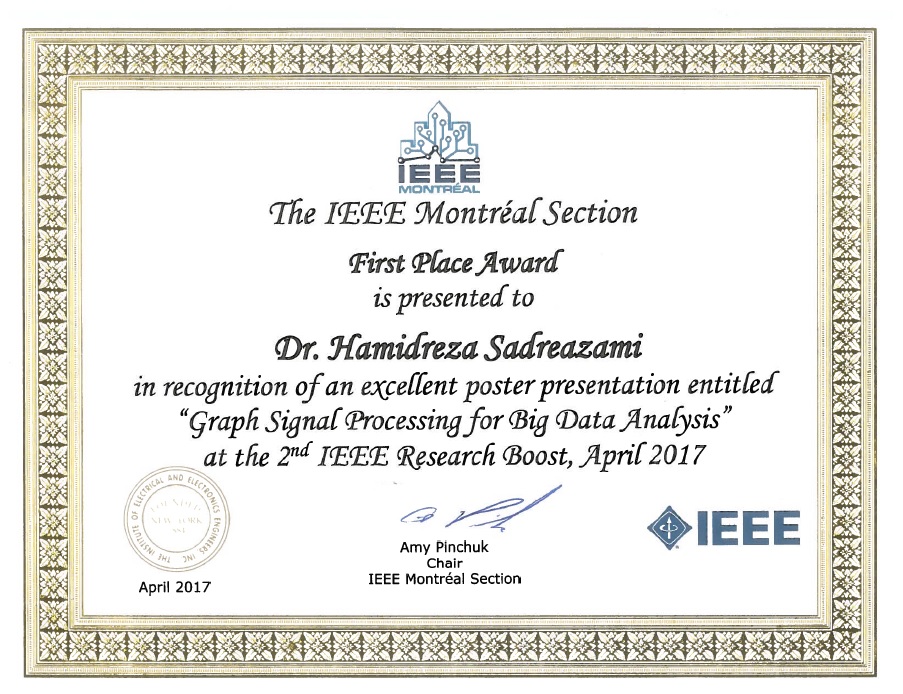
-
Apr 2017Conference and Exposition Award, Concordia Uni.
-
Jan 2017Nominated for Prix d'excellence de l'Association des doyens des tudes suprieures au Qubec (ADESAQ).
-
Jan 2017Nominated for CAGS/UMI Distinguished Dissertation Awards.
-
Jun 2016Nominated for the Concordia Best Thesis Award.
-
Apr 2016Nominated for the Concordia Teaching Assistantship Award.
-
Apr 2016ReSMIQ Conference Award.
-
Dec 2015Conference and Exposition Award, Concordia Uni.
-
Oct 2015ECSGA Travel Award.
-
Jul 2015Concordia Accelerator Award.
-
May 2015IEEE ISCAS Travel Support.
-
Apr 2015IEEE Circuits & Systems Society (CASS) Travel Award.
-
Apr 2015Conference and Exposition Award, Concordia Uni.
-
Mar 20151st place award at ECE-GSR paper competition, Concordia Uni.

-
Mar 2015Conference and Exposition Award, Concordia Uni.
-
Oct 2014ECSGA Travel Award.
-
Apr 2014Conference and Exposition Award, Concordia Uni.
-
Apr 2014ReSMIQ Conference Award.
-
Mar 2014Concordia ENCS Travel Support.
-
2012 and 2013Partial tuition scholarship, Concordia Uni.
Research Summary
In Biosignals and Systems Analysis Lab at McGill University, I was involved in a time-varying functional brain connectivity related project using artificial intelligence. More specifically, using multimodal neuroimaging data (simultaneous fMRI-EEG, MEG), I investigated the time-varying characteristics of resting-state networks over different time scales, as well as quantifying the effect of physiological fluctuations (pressure, heart rate, respiration) on fMRI-based resting-state connectivity.
In Biomedical Signal Processing Lab at University of Ottawa, I worked
on several projects including:
(i) I worked on vital sign monitoring using contactless bistatic ultra wide-band radar. More specifically,
respiration and heartbeat rates are estimated and the posture of targets are detected using supervised learning methods.
(ii) In a human activity monitoring project, I worked on event detection/recognition problem for home care purposes.
More specifically, fall detection algorithms are developed using deep learning approaches in order to assist the elderly.
In Intelligent Signal & Information Processing Lab at Concordia University, I worked on several projects including:
(i) analyzing large-scale data using graph-based signal processing. This work was
partnered by Ericsson-Montreal with a focus on intrusion detection in cloud systems
by online auditing. In addition, I worked on graph-based reachability
assessment of the cloud entities in cloud networks. More specifically, unsupervised intrusion detection
scheme in cloud networks was developed. In addition, a supervised graph-based
anomaly detection scheme was developed using the statistical modeling in cyber physical
systems with embedded sensors; (ii) Two classification algorithms for motor imagery-based brain
computer interface were developed. First, graph-based spatio-temporal filters were
devised to efficiently identify subject-specific features from brain activity signals and translate
them into device commands. Second, a CSP-based deep convolutional neural network was
trained for classification of left/right hand/foot MI-BCI signals; (iii) Using graph signal processing
framework, I developed iterative graph-based filtering applied in both vertex and spectral
domains for image abstraction, stylization and saliency detection purposes.
Interests
- Image Processing
- Biomedical Signal Processing
- Graph Signal Processing
- Machine Learning
- Brain Computer Interfaces
- Remote Sensing
- Human Activity Recognition
Collaborators
Research Collaboration
I enjoy a great professional collaboration with researchers across the world. We have a very professional, friendly and enthusiastic research members in a variety of research domains or academic positions. We also welcome whoever is willing to share and promote the knowledge by joining our research group.
Publications
h-index: | i10-index: | Citations: |
Filter by type:
Sort by year:
Teaching
Course Instructor
-
Summer 2017
ENCS 6021 - Engineering Analysis II
Delivered 3-hour lectures on Engineering Analysis II to 45 graduate students at Concordia University.
Guest Lectures
-
Summer 2017
ENGR 213-Applied Ordinary Differential Equations
Delivered a 2.5-hour lecture on Applied Ordinary Differential Equations to 25 undergraduate students at Concordia University.Fall 2016ELEC 6161-Probability and Stochastic Processes
Delivered a 2.5-hour lecture on Probability and Stochastic Processes to 20 graduate students at Concordia University.Fall 2014COMP 361-Elementary Numerical Methods
Delivered a 2.5-hour lecture on Elementary Numerical Methods to 55 undergraduate students at Concordia University.
Teaching Experience as Teaching Assistant
-
Winter 2016
ENGR 233-Applied Advance Calculus
COMP 361-Elementary Numerical Methods
ELEC 365-Complex Variables & Partial Differential Equations
ENGR 213-Applied Ordinary Differential Equations
Fall 2016ELEC 275- Principals of Electrical Engineering
COMP 361-Elementary Numerical Methods
Summer 2015ENGR 233-Applied Advance Calculus
ELEC 275- Principals of Electrical Engineering
Winter 2015ENGR 233-Applied Advance Calculus
COMP 361-Elementary Numerical Methods
ELEC 365-Complex Variables & Partial Differential Equations
ENGR 213-Applied Ordinary Differential Equations
Fall 2014ENGR 213-Applied Ordinary Differential Equations
COMP 361-Elementary Numerical Methods
Summer 2014ENGR 233-Applied Advance Calculus
ELEC 264-Signals & Systems I
Winter 2014ENGR 233-Applied Advance Calculus
ELEC 264-Signals & Systems I
COMP 233- Probability & Statistics for Computer Science
Fall 2013ENGR 233-Applied Advance Calculus
ENGR 213- Applied Ordinary Differential Equations
COMP 361-Elementary Numerical Methods
Summer 2013ENGR 233-Applied Advance Calculus
Winter 2013ENGR 233-Applied Advance Calculus
COMP 361-Elementary Numerical Methods
ELEC 365-Complex Variables & Partial Differential Equations
Fall 2012ENGR 233-Applied Advance Calculus
Lab Instructor
-
Fall 2014
ELEC 364-Signals & Systems II
Winter 2014ELEC 275- Principals of Electrical Engineering
Fall 2013ELEC 275- Principals of Electrical Engineering
Fall 2013ELEC 364-Signals & Systems II
Fall 2012ELEC 364-Signals & Systems II
Contact Me
Contact Me
McGill University
My office is located at the following address:
361 McConnell Engineering Building,
Bio-engineering Department
817 Sherbrooke Ave W
Montreal, QC, H3A 2A7, Canada.
Tel : +1-514-5570594
E-mail : hamidreza dot sadreazami at mail dot mcgill dot ca
